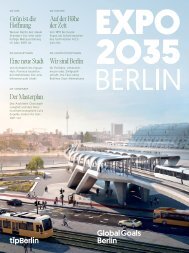EXBERLINER Issue 170, April 2018
You also want an ePaper? Increase the reach of your titles
YUMPU automatically turns print PDFs into web optimized ePapers that Google loves.
REGULARS<br />
Save<br />
Berlin<br />
by Dan Borden<br />
Mute’s<br />
Mega-Berlin<br />
Dan watched the Netflix flop<br />
to find out how our city’s<br />
future stacks up.<br />
As a film, the recent Netflix thriller Mute is a<br />
derivative bore. But for those of us fretting<br />
over Berlin’s future, Duncan Jones’ sci-fi vision<br />
is a blast. As our city drifts toward neutered<br />
mediocrity, the director promises the<br />
Berlin of 2052 will be a souped-up version<br />
of the seedy 1970s playground inhabited by<br />
his dad, David Bowie.<br />
Bowie moved to Schöneberg in 1976, seduced<br />
by Weimar Berlin’s 1920s decadence,<br />
and produced his signature album, Heroes.<br />
While Mute’s hero Leo Beiler (Alexander<br />
Skarsgård) searches the Berlin of tomorrow<br />
for his missing girlfriend, director Jones goes<br />
back and reconstructs the wild and crazy<br />
Cold War Berlin he glimpsed visiting his<br />
father as a kid.<br />
In Mute’s alternate future, American<br />
soldiers still patrol the streets where insults<br />
like “commie” and “yankee” are bandied<br />
about, and everyone still uses deutschmarks<br />
– printed with Angela Merkel’s face. But the<br />
Berlin Wall is gone. A car chase through West<br />
Berlin ends at the East Berlin restaurant<br />
Ständige Vertretung, and Leo picnics next<br />
to the Brandenburg Gate, shown wedged between<br />
tall buildings. The best part of Jones’<br />
alternate future: Berlin’s tight-assed city<br />
planners have learned to relax and love two<br />
current no-nos, neon signs and skyscrapers.<br />
In 30 years, Mitte will be a forest of glowing<br />
towers, like Dubai on the Spree.<br />
The film doesn’t offer cameos by survivors<br />
of Bowie’s Berlin like Iggy Pop, Brian<br />
Eno or Romy Haag, but it gives screen time<br />
to three Cold War landmarks we’re lucky to<br />
still have around:<br />
Kotti apotheosis<br />
Mute’s hero Leo crosses paths with his nemesis<br />
Cactus Bill (Paul Rudd) in a scene filmed<br />
at Kottbusser Tor, in today’s Kremanski cafe.<br />
It’s a ground level storefront in that sprawling<br />
mega-project, the Neues Kreuzberger<br />
Zentrum. Opened in 1974, the complex was<br />
aimed at upgrading/sanitising a seedy corner<br />
of then-West Berlin – with the unspoken goal<br />
of scaring away the growing immigrant population.<br />
It didn’t work. Today, 70 percent of its<br />
300 flats are occupied by non-Germans. In<br />
<strong>April</strong> 2017, city-owned housing company Gewobag<br />
bought the complex, guaranteeing its<br />
survival as affordable housing into the 22nd<br />
century. But Mute literally takes the building<br />
to the next level, showing it doubled in height.<br />
Leo is seen traversing the project’s upperlevel<br />
“street-in-the-sky”, a feature planned<br />
but never completed in the 1970s due to<br />
budget cuts.<br />
Westside UFO<br />
While scouting futuristic Berlin locations,<br />
director Jones was psyched to stumble on<br />
Charlottenburg’s Internationales Congress<br />
Centrum (ICC). He described the late-1970s<br />
megastructure to entertainment website<br />
IGN: “It looks like a spaceship from Battlestar<br />
Galactica that’s just landed in the city...<br />
[and] on the inside it looks like a Kubrick<br />
set.” In Mute, the ICC’s lobby plays a mid-<br />
In Netflixe’s Mute, Mitte’s<br />
Kraftwerk is transformed into<br />
a futuristic red-light district.<br />
21st-century shopping mall. In reality, the<br />
asbestos-filled building has been unused<br />
since 2014 and was threatened with demolition<br />
until Berlin’s Senat kicked in €200<br />
million to save it last year. Its future function<br />
isn’t fixed, but they’ve singled out one option<br />
not on the table: shopping centre.<br />
Ossi AC/DC<br />
The seedy underbelly of Mute’s Berlin is a<br />
steamy, multi-level red light district. Signs<br />
for a fictional Rudi-Dutschke-Straße S-Bahn<br />
station place it blocks from Checkpoint<br />
Charlie, but it was actually shot inside a<br />
cavernous Cold War-era power plant. The<br />
Kraftwerk Mitte on Köpenicker Straße<br />
began generating East Berlin’s electricity<br />
in 1964. Shuttered in 1997, it’s been revived<br />
as a stunning event venue and home to the<br />
dance club Tresor.<br />
Director Jones should have waited. Blocks<br />
from the real Checkpoint Charlie, a new<br />
building’s going up that’s destined to rank<br />
among the city’s futuristic megastructures.<br />
The Axel Springer Neubau, by Dutch architect<br />
Rem Koolhaas, will be a high-tech office<br />
block with gaps in its skin revealing a cavelike<br />
atrium. Set to open in 2020, it will be<br />
daring, quirky and a camera-ready backdrop<br />
for Berlin’s real-life sci-fi future. ■<br />
The Berlin of 2052 will be a<br />
souped-up version of the seedy<br />
1970s playground inhabited by<br />
David Bowie.<br />
50<br />
<strong>EXBERLINER</strong> <strong>170</strong>

















